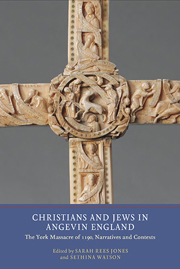Book contents
- Frontmatter
- Contents
- List of Illustrations
- Contributors
- Editor's Preface and Acknowledgments
- Abbreviations
- Introduction: The Moment and Memory of the York Massacre of 1190
- Part I The Events of March 1190
- Part II Jews among Christians in Medieval England
- Part III Representations
- 12 Egyptian Days: From Passion to Exodus in the Representation of Twelfth-Century Jewish-Christian Relations
- 13 ‘De Judaea, muta et surda’: Jewish Conversion in Gerald of Wales's Life of Saint Remigius
- 14 Dehumanizing the Jew at the Funeral of the Virgin Mary in the Thirteenth Century (c. 1170–c. 1350)
- 15 Massacre and Memory: Ethics and Method in Recent Scholarship on Jewish Martyrdom
- 16 The Future of the Jews of York
- Afterword: Violence, Memory and the Traumatic Middle Ages
- Bibliography
- Index
- York Medieval Press: Publications
16 - The Future of the Jews of York
from Part III - Representations
Published online by Cambridge University Press: 05 May 2013
- Frontmatter
- Contents
- List of Illustrations
- Contributors
- Editor's Preface and Acknowledgments
- Abbreviations
- Introduction: The Moment and Memory of the York Massacre of 1190
- Part I The Events of March 1190
- Part II Jews among Christians in Medieval England
- Part III Representations
- 12 Egyptian Days: From Passion to Exodus in the Representation of Twelfth-Century Jewish-Christian Relations
- 13 ‘De Judaea, muta et surda’: Jewish Conversion in Gerald of Wales's Life of Saint Remigius
- 14 Dehumanizing the Jew at the Funeral of the Virgin Mary in the Thirteenth Century (c. 1170–c. 1350)
- 15 Massacre and Memory: Ethics and Method in Recent Scholarship on Jewish Martyrdom
- 16 The Future of the Jews of York
- Afterword: Violence, Memory and the Traumatic Middle Ages
- Bibliography
- Index
- York Medieval Press: Publications
Summary
William of Newburgh's History of English Affairs grants an access to the troubling events of 1190 unmatched by other sources. It is difficult to resist portal analogies when speaking of the world we glimpse in his vigorous Latin prose. Detailed and wide-ranging, Newburgh's narrative enables the reader to feel a witness to unfolding incidents. He creates a sense of privileged access to a vivacious world of complicated human actors, of local and national forces on the move. Yet the story Newburgh tells is partial, framed by the doorway he constructs around its contours to give the tale coherence. His narrative is shaped by his reading, his desires. Sometimes, moreover, within this metaphorical ingress into English history a literal door will swing open, proffering an unexpected invitation to consider the stories Newburgh does not recount.
Towards the close of the first book of the History, such a gateway suddenly appears in rural Yorkshire. A drunken traveller is returning home late at night when the noise of revelry issues from what had been a familiar landmark, a roadside tumulus: ‘He heard voices singing, as though people were feasting in celebration (‘quasi festive convivantium’).’ Newburgh assures us that he knows this mound himself, having viewed its topographical ordinariness numerous times. Though the hill has never before offered anything other than a grassy slope, this evening a doorway has opened into its side, revealing ‘a large, well-lit dwelling (‘domum amplam et luminosam’) crowded with men and women reclining at table as at a formal feast’.
- Type
- Chapter
- Information
- Christians and Jews in Angevin EnglandThe York Massacre of 1190, Narratives and Contexts, pp. 278 - 293Publisher: Boydell & BrewerPrint publication year: 2013

